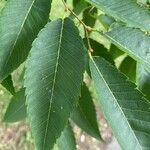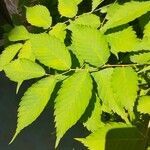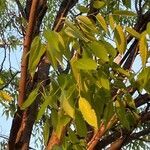Trees, to 30 m tall, d.b.h. to 1 m, deciduous. Bark grayish white to grayish brown, exfoliating. Branchlets brownish purple to brown, pubescent or glabrescent. Winter buds conic-ovoid to ovoid. Stipules brownish purple, lanceolate, 7-9 mm. Petiole 2-6 mm, pubescent; leaf blade elliptic to ovate-lanceolate, 3-10 × 1.5-5 cm, papery to thickly papery, glabrous or abaxially sparsely pubescent along veins, adaxially sparsely hispid, base slightly oblique, rounded, or shallowly cordate, margin serrate to crenate, apex caudate-acuminate; secondary veins 9-15 on each side of midvein. Male flowers: shortly pedicellate, ca. 3 mm in diam. Perianth (5 or)7(or 8)-parted to middle. Female flowers: subsessile, ca. 1.5 mm in diam. Perianth 4-or 5(or 6)-parted. Ovary pubescent. Drupes pea green, subsessile, 2.5-3.5 mm in diam., surface covered by an irregular network of low ridges. Fl. Apr, fr. Sep-Nov. 2n = 28.
More
A medium sized deciduous tree. It grows to 20-40 m high. The branches are straight and spreading. They form a neat rounded crown. The bark is smooth when young. It flakes to reveal orange patches. The leaves are alternate and have a long sharp tip. The leaves are oval and 3-11 cm long by 1.3-7 cm wide. They have saw like teeth. The leaves turn orange and yellow in autumn. Male and female flowers occur on the same twig. They are green and small. The fruit is small and round.
It is a temperate plant. It is native to China, Japan and Korea. It grows in moist soil near streams. It can tolerate some shade. It needs a moist soil. It suits hardiness zones 5-9. Arboretum Tasmania. Hobart Botanical Gardens. Burnie Rhodo Gardens. In Sichuan.
More
Lowlands and mountains. Valleys, beside streams; at elevations from 500-2,000 metres.




